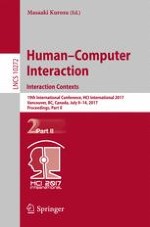The two-volume set LNCS 10271 and 10272 constitutes the refereed proceedings of the 19th International Conference on Human-Computer Interaction, HCII 2017, held in Vancouver, BC, Canada, in July 2017.
The total of 1228 papers presented at the 15 colocated HCII 2017 conferences was carefully reviewed and selected from 4340 submissions. The papers address the latest research and development efforts and highlight the human aspects of design and use of computing systems. They cover the entire field of Human-Computer Interaction, addressing major advances in knowledge and effective use of computers in a variety of application areas. The papers included in this volume cover the following topics: games in HCI; mobile and wearable interaction; HCI, children and learning; and HCI in complex human environments.
